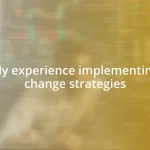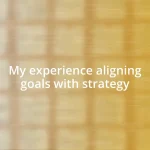Key takeaways:
- Strategic creativity balances imaginative thinking with practical goals, transforming ideas into actionable plans.
- Fostering a creative environment enhances collaboration and problem-solving, leading to innovative solutions and team growth.
- Overcoming barriers like self-doubt, time constraints, and resistance to change is essential for unlocking creativity and driving innovation.

Understanding strategic creativity
Strategic creativity is about merging innovative thinking with practical goals. I remember a project where I had to devise a marketing campaign with a tight budget but high expectations. It forced me to think outside the box—how could I be creative and still meet the organization’s objectives?
When I think about strategic creativity, I see it as a balance between imagination and strategy. It’s not just about having wild ideas; it’s about channeling those ideas into actionable plans. I once worked with a team that had several fantastic concepts, but we struggled to align them with our business goals. Had we considered how our creative sparks could directly drive results, we might have turned those ideas into something truly impactful.
Exploring strategic creativity invites us to ask: How can we transform creative thought into meaningful outcomes? My experience shows that it’s vital to keep asking these questions throughout the brainstorming process. Strategic creativity isn’t a one-time event; it’s an ongoing dialogue between possibility and purpose that can lead to profound insights.

Importance of fostering creativity
Fostering creativity is essential for driving innovation and problem-solving. In one of my past roles, we faced a significant challenge in improving employee engagement. Instead of following traditional methods, we held brainstorming sessions that encouraged everyone to share their ideas, no matter how unconventional. The result was a surge of enthusiasm, and we developed initiatives that truly resonated with the team, immensely boosting morale.
Creativity enriches collaboration. I vividly recall a project where I teamed up with colleagues from different departments. Their unique perspectives sparked new ideas I never considered. I believe that by fostering an environment where diverse voices are encouraged, we not only blend different experiences but also create a tapestry of innovation that can address complex challenges effectively.
Ultimately, fostering creativity transforms a workplace into a thriving ecosystem. When I create spaces for open dialogue, I’ve seen how individuals flourish, pushing boundaries and breaking silos. It’s powerful to witness this growth, as teams come together with a shared vision—a vision that becomes richer and more vibrant through creativity.
| Benefits of Fostering Creativity | Examples from Experience |
|---|---|
| Improved Problem-Solving | Creative brainstorming sessions led to innovative solutions for employee engagement. |
| Enhanced Collaboration | Cross-departmental teamwork generated unexpected and valuable insights. |
| Growth and Development | Creating open dialogue spaces allowed individuals to thrive and contribute meaningfully. |

Techniques for encouraging creative thinking
Encouraging creative thinking often requires opening the door to new experiences and perspectives. One technique I’ve found particularly effective is creating a “no-idea-is-a-bad-idea” atmosphere. During one brainstorming session, we focused solely on generating concepts without any judgment attached. It felt liberating! Ideas that seemed silly at first turned into the seeds of innovative solutions once we revisited them with fresh eyes. This approach not only encourages participation but also establishes a sense of safety in sharing even the most unconventional thoughts.
Here are some techniques that can help foster an environment for creative thinking:
-
Diverse Team Composition: Invite team members from various backgrounds and expertise. Their unique perspectives can spark unexpected ideas.
-
Structured Brainstorming Sessions: Implementing guidelines, like the “no judgment” rule, can help participants feel free to share openly.
-
Playful Exercises: Incorporate games or creative challenges that are light-hearted yet thought-provoking; they often unleash creativity in surprising ways.
-
Mind Mapping: Visualizing thoughts through diagrams can help individuals connect seemingly unrelated ideas.
By integrating these techniques into your routine, I believe you’ll unlock a treasure trove of creative potential within your team. It transforms the simple act of idea generation into an exhilarating adventure.

Building a creative team environment
Creating a vibrant, creative team environment is all about fostering trust and open communication. I remember a time when my team started weekly “idea jams,” where we would gather not just to discuss work but to share any and all creative thoughts—personal or professional. It was amazing to see how quickly barriers fell, and how sharing personal stories around a coffee could lead to breakthroughs in our projects. What if those personal insights are the key to sparking innovation?
Each member of the team deserves to feel valued for their unique contributions. Early in my career, I noticed how encouraging quiet team members to share their thoughts brought out ideas that profoundly shaped our direction. Those moments taught me the value of patience and active listening. It’s fascinating to think—how often do we overlook the quieter voices that might hold the secret to our next big idea?
Moreover, the physical space we work in can greatly impact creativity. I’ve experienced firsthand the difference an open, flexible workspace can make. Not only did it allow for spontaneous brainstorming sessions, but it also fostered a sense of community among us. Just think—a simple change in layout could lead to a dynamic shift in how ideas flow. Wouldn’t that be a game changer for any team?

Real-life examples of creative success
One of the most inspiring examples of creative success I witnessed was during a marketing campaign for a local artisanal market. My team brainstormed ideas that felt outlandish at first—a pop-up art installation showcasing the work of local artisans. Surprisingly, this became the centerpiece of our promotion. People were drawn in, transforming a simple campaign into an immersive experience that not only boosted sales but also fostered community engagement. Can you imagine the energy when art and commerce collide like that?
Another unforgettable moment occurred during a product development session. We were stuck in a rut until one team member suggested we flip our usual perspective, asking, “How would our competitors tackle this?” This lightbulb moment led us to completely rethink our approach. I still remember the rush of excitement when our new idea took shape, ultimately resulting in a product launch that far exceeded our expectations. It makes me wonder—what’s the power of simply looking at challenges from another angle?
Lastly, I once attended a creative workshop where we utilized improv storytelling as a method for generating campaign ideas. At first, I was skeptical; it felt like play. But as we wove spontaneous narratives, I realized this exercise opened up paths for deeper, more authentic connections to our brand message. That day, laughter turned into inspiration, showcasing how untamed creativity can unearth gems. Have you ever found something unexpectedly beneficial in a place you didn’t expect? It’s a reminder of how creativity can flourish when we step outside our comfort zones.

Overcoming barriers to creativity
One of the biggest barriers I’ve encountered in nurturing creativity is self-doubt among team members. I recall a brainstorming session where one talented colleague held back, fearing her ideas weren’t good enough. I gently encouraged her to share, and when she did, her concept sparked a lively discussion that carried our project in an entirely new direction. Isn’t it interesting how often we underestimate the brilliance that lies within us and others?
Navigating time constraints can also stifle creativity. During a hectic product launch, my team faced immense pressure. Instead of pushing through with conventional solutions, we decided to carve out just 20 minutes for a rapid-fire idea session. Surprisingly, those focused minutes yielded more innovative ideas than days of traditional meetings ever had. It makes me wonder—how can we create room for creativity in the midst of our busy schedules?
Finally, resistance to change can be a formidable wall against creative thinking. I’ve experienced this firsthand when introducing new tools to my team. Initially, there was skepticism. However, by hosting a fun workshop to showcase how these tools could enhance our workflow, team members began to embrace the change. Watching their enthusiasm grow was incredibly rewarding. Have you ever faced a hurdle that turned into an opportunity for growth? It’s moments like these that remind me how embracing change can pave the way for innovation.















